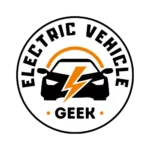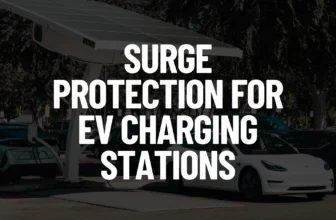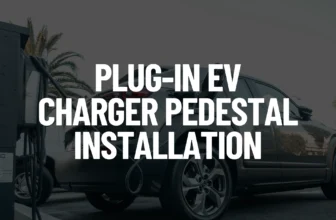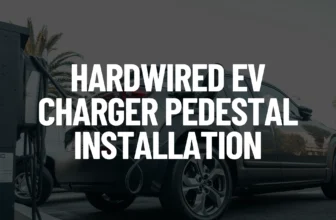We decided to integrate solar EV charging into our Enphase IQ 50 EV charger installation, this was after the recent flooding that affected our grid electricity power and we were cut off from grid power for a few days before restoration, we decided to take matters in our own hands and integrate renewable energy into our Enphase EV charger installations.
Integrating solar EV charging into our set-up might seem simple, however, there are various factors that we need to consider before purchasing EV solar charging accessories and upgrading our EV charging electrical setup.
We needed to sit down and analyze our solar panel system choice, energy storage options, solar energy productions, and system design, installation, and functionality – these factors would determine our choices for rooftop solar modules, micro converters, current transformer (CT) meter, and the charger to use, in our case we wanted to install a solar EV charging system to the Enphase IQ 50 EV charger, which is optimized for use with solar installations.
The Enphase IQ 50 is a smart Level 2 EV charger that offers convenient charging for your electric vehicle with acceptance rates up to 9.6kW, adding up to 38 miles of range per hour, read our full review on the Enphase IQ 50 EV charger.
Table of Contents
Our Enphase EV Charger Standalone Configurations (Before Upgrade)
Our Enphase EV charger standalone configurations connected to the main panel before upgrading to solar + EV charger configurations looked like this:
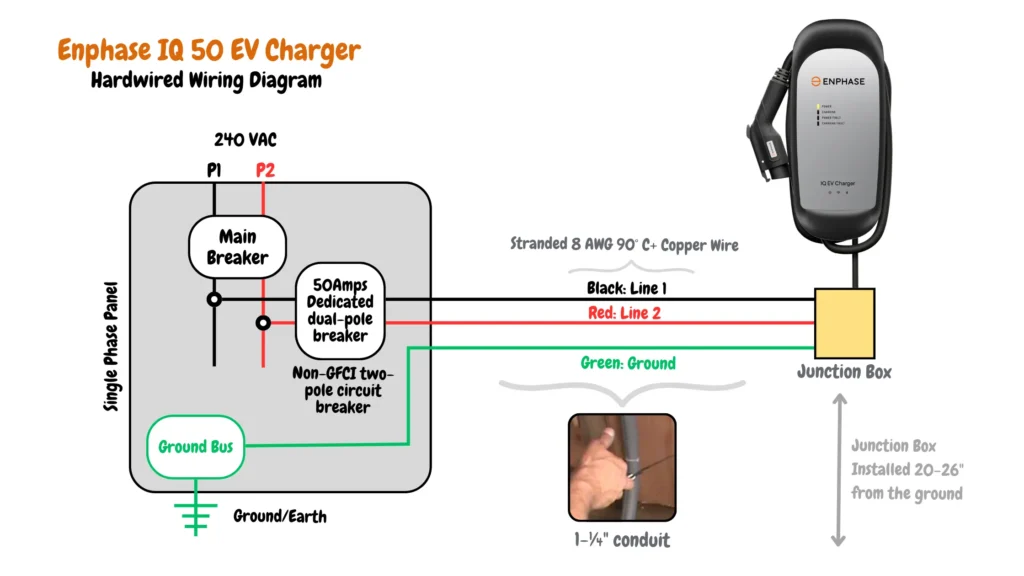
As you can see from our Enphase EV charger standalone configurations set up above, we already have a dedicated 50 A circuit breaker and wiring that supports the EV charger load that we have been using with the IQ EV Charger 50 for the last few months.
Read more on our initial Enphase EV charger standalone configurations in our Enphase IQ 50 EV Charger Review.
Integrating Solar Power with the Enphase IQ 50 EV Charger
To integrate solar with our Enphase 1Q 50 EV charger we needed to purchase additional EV charging solar accessories such as rooftop solar modules, racking systems, micro converters, and current transformer (CT) meter, energy management and remote monitoring system, and a solar combiner box.
Here are the schematics on how we Integrated solar power with our Enphase IQ 50 EV Charger.
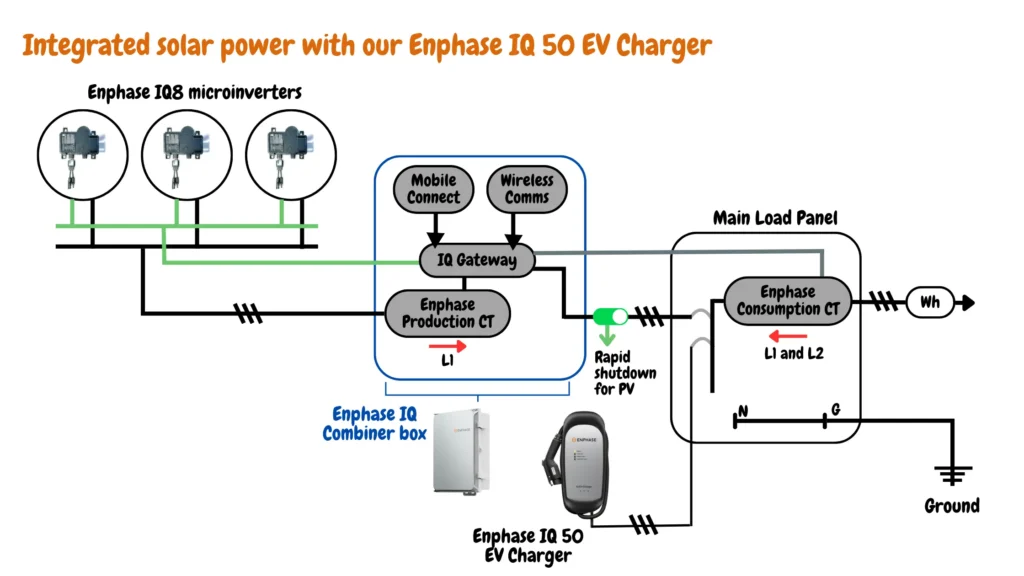
Our Choice for EV Charging Solar Panels.
We invested in a 10kW SunPower Solar panel which is a bit costly, we advise spending more on quality solar panels, and less on energy storage, and our number one recommendation and our choice was SunPower panels, other panels we considered included REC and QCells solar panels.
We prioritized efficiency and reliability when choosing solar panels for our EV charging setup. Solar panels were our most expensive expenditure, accounting for more than 70% of our total cost even after considering we got a 30% federal tax credit and $1,000 cash rebate. The high costs had us looking for financing offers and we opted not to purchase solar panels with loan options as associated fees were up to 12% and we had a tight budget and appreciated as much cost savings as possible.
While SunPower panels come at a premium cost, their high efficiency (20.3% to 23%) translates to generating more power per square foot of roof space. This is crucial for maximizing the amount of solar energy we can use for EV charging.
Furthermore, SunPower’s reputation for quality and their impressive 25-year workmanship and performance warranty gave us peace of mind. This long warranty is a valuable assurance for a significant investment like solar panels.
Best Micro Converters for EV Charging.
We opted for micro converters because they maximize energy production as they are attached to each panel in our roof, if one panel misfunctions or is blocked the other panels won’t be affected, micro converters will also allow us to monitor panel level performance allowing us to track output of each solar panel.
When choosing micro-converters to use in our EV solar charging set-up we had two options use M-Series microinverters or use IQ6/7/8 microinverters, we researched the reliability of the two and how they might affect our future upgrade choices such as adding batteries and car charging choices down the line, and also optimizing our EV charging and overall energy management.
We opted for Enphase IQ8 microinverters because they offer the flexibility to upgrade our EV charging solar installation by integrating with battery storage in the future, although they are a bit more costly than M-Series microinverters, the high cost was justified by the efficiency provided by IQ8 microinverters than M-Series microinverters when it comes to converting DC power from the solar panels to AC power.
Our choice of Enphase IQ8 microinverters was due to futureproofing our Solar installation system, if you are not concerned with future-proofing or upgrading your solar installation system, then the M/S Series micro converters might be the right choice for you.
Solar EV Charging Combiner Box
We needed a central connection point for the wiring from our multiple SunPower panels wires coming from the roof, we bought the Enphase IQ Combiner box, and it is compatible with the IQ8 Series that we had bought for use on our Enphase IQ 50 solar EV charging set-up.
No products found.
We recommend integrating a combiner box for a well-designed solar power EV charging set-up, it will make the process of installing and maintenance easier, and reduce the installation and maintenance time and costs.
Our Solar EV Charging Current Transformer (CT) Meter
We figured we would need to install two current transformers, Production CT to measure the current flowing out from your solar panels into the grid, and Consumption CT designed to clamp over wire/bus bar feeding the main breaker to track the total electricity consumed.
To save on cost we bought the Enphase Envoy S Metered which can perform consumption monitoring and includes a production CT that is paired and calibrated to the Envoy S at the factory.
No products found.
We choose the Envoy S as our communication gateway to provide energy usage insights, remote software updates, and EV charging load management, especially considering we plan on upgrading our Solar EV charging set-up by including energy storage batteries, system and load controllers, the Enphase Envoy S connects Enphase IQ8 microinverters and the Enphase Cloud for remote monitoring for smart EV Solar charging functionalities in our solar EV charging set-up.
We installed our production CT on the solar panel circuit (L1), while the Consumer CT was installed on the main utility feed (L1 and L2) as shown in our schematics above on how we Integrated solar with our Enphase IQ 50 EV Charger. We recommend installing the Envoy S close to the load center so that the CT can reach the load panel.
We bought our main load panel knowing that we would add additional accessories to the main load panel such as current transformers, unfortunately, most home main load panels we have encountered don’t allow the installation of CTs as there is not enough room for additional accessories, if you are in this boat – and would like to add a consumption CT to your solar set-up we recommend considering a panel upgrade.
Conclusions.
This installation set-up is complete and we have been using it for the last few days without any issues, we can monitor and sync with the Enphase app. We plan on upgrading the set-up by including battery storage systems that will offer us more independence from the grid and provide access to stored electrical power during blackouts, which would mean including load and system controllers, so keep checking Electrical Vehicle Geek for this set-up upgrade to a solar + battery EV charging set-up.

James Ndungu is a certified EV charger installer with over five years of experience in EVSE selection, permitting, and installation. He holds advanced credentials, including certification from the Electric Vehicle Infrastructure Training Program (EVITP) and specialized training in EV charging equipment and installation, as well as diplomas in EV Technology and Engineering Fundamentals of EVs. Since 2021, James has tested dozens of EV chargers and accessories, sharing expert insights into the latest EV charging technologies.
Last update on 2025-07-09 / Affiliate links / Images from Amazon Product Advertising API
